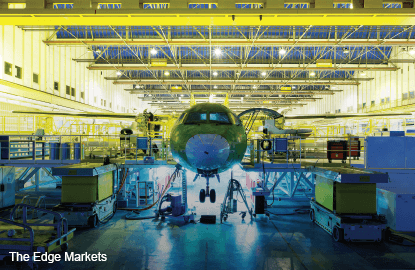
This article first appeared in The Edge Malaysia Weekly, on February 22-28, 2016
Amid slowing growth in Asia-Pacific economies and a glut of aircraft among jet manufacturers, ATR — the world’s largest manufacturer of turboprop aircraft — expects orders for its regional (short-haul) aircraft to increase by 6.5% this year.
A joint venture between Airbus Group and Finmeccanica, ATR has traditionally been strong in its home market — Europe. But since 2014, Southeast Asia has overtaken Europe as the single largest market for ATR’s turboprop aircraft in the world, CEO Patrick de Castelbajac said during a press conference with regional media at the Singapore Airshow 2016 last Tuesday.
“In terms of the market, Southeast Asia is the centre of the world for ATR. There is no other place that has got more ATR aircraft flying than this region.
“So, the region is important today and I believe it will be even more important tomorrow because the growth is still there,” Castelbajac said.
While other aircraft manufacturers have had to contend with deferred deliveries due to the slowing economy and supply glut, ATR is projecting sustained growth in orders for its turboprop aircraft, he added.
“Although the pace of economic growth has slowed a little bit, I don’t see it as a slowing down in terms of traffic needs. Many countries here are fast-growing and even though they may be growing a little less than before, they are still growing fast.
“And to grow fast, they need business people to travel from one city to another, they need people and goods to move. Today, the cheapest way to move from one place to another is with ATR. That is why we are very confident of the prospects of ATR in this region and we intend to see the growth of ATR continue in this region,” Castelbajac remarked.
Globally, ATR has a backlog order of 260 turboprop aircraft as at last year, with 40% of the orders coming from Asia-Pacific. At the listed price of about US$25 million (RM105.4 million) per unit, ATR’s backlog orders are worth US$6.6 billion, which will keep the group busy over the next three years.
Indonesia’s Lion Group became ATR’s largest customer in 2014 when it added another 40 aircraft to its order, increasing it to 100 aircraft. Malaysia is also a major market for ATR following the expansion of Malindo Air, an affiliate of Lion, and Firefly in the short-haul regional routes over the last five years.
Out of the 100 ATR 72-600 ordered by Lion, 48 have been delivered to its Indonesian regional airline Wings Air and 11 to Malindo Air. ATR revealed that Lion will receive another seven ATR 72-600 this year.
Apart from Lion, Indonesia’s flag carrier, Garuda Indonesia, is also a major customer of ATR, with 35 aircraft on order and 11 delivered so far. ATR said Garuda Indonesia will receive four new aircraft this year.
Indonesia is the focal point of ATR’s growth in Southeast Asia, as the archipelagic nature of the nation makes it an ideal location for small regional aircraft to be used, connecting small communities with cities, and small cities with major economic hubs.
The average distance of regional flights in Indonesia is about 350km — ideal for ATR’s turboprop aircraft, which are typically used on routes of less than 500km.
The ATR 72-600 is the latest addition to ATR’s family of aircraft. The group claims the ATR 72-600 has the lowest cash operating cost per trip in a 460km sector compared with its closest competitors, be they turboprop aircraft or regional jets.
The ATR 72-600 typically seats between 68 and 74 passengers, with a maximum take-off weight of 23,000kg. With a full passenger load, it has a maximum range of 1,665km, although airlines usually use the aircraft for routes less than 500km.
Over the last five years, orders for ATR’s turboprop aircraft by Southeast Asian airlines have grown by 75%, according to the group. Of the regional aircraft in operation in Southeast Asia, 92% are ATR’s. This is compared with 70% in the larger Asia-Pacific market and 37% worldwide.
This shows the importance of Southeast Asia to ATR’s operation. Major users of the group’s turboprop aircraft in the region include Lion, Garuda Indonesia (with Citilink as its regional subsidiary), Malaysia Airlines Bhd, through Firefly and MASwings, and Cebu Pacific Air.
In Thailand, ATR has a long history of collaboration, having had a presence in the country since 1989. It was the first country in Southeast Asia to have ATR’s turboprop aircraft in operation. With an average regional route of 410km, they are suited for Thailand.
Moving forward, ATR is entering new markets, including Japan and China. In Japan, ATR achieved a breakthrough last year after Amakusa Airlines Co Ltd, a regional affiliate of Japan Airlines, received its first ATR 42-600 aircraft.
In China, ATR opened its representative office in Beijing last year. The country presents a huge opportunity as only 2.5% of total civil aircraft in China currently are regional aircraft with fewer than 90 seats, said ATR. This is compared with 25% worldwide.
The company, which is based in Toulouse, France, is also coming up with new configurations based on the ATR 72-600.
In November 2015, ATR introduced “Cargo Flex”, an enhanced cargo version that not only offers more passenger load but also has cargo as an essential payload. PNG Air of Papua New Guinea has begun using this aircraft.
ATR has also come up with a high-density cabin version, with a 78-seat configuration, based on its ATR 72-600. It will be introduced by Cebu Pacific Air in August 2016, used on routes with strong demand but with a low-cost model.
Save by subscribing to us for your print and/or digital copy.
P/S: The Edge is also available on Apple's AppStore and Androids' Google Play.